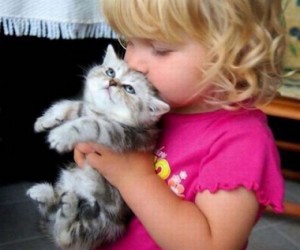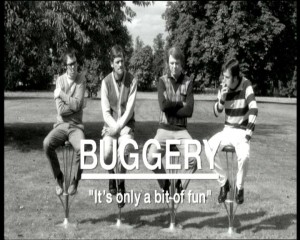Humans face the adaptive problem of forming and maintaining social bonds with others. Our ability to bond is rather extraordinary. As one example of our capacity to bond, like many people, I am a (habitual) pet owner. My personal preference – though I like most mammals – is towards cats, and I’ve had at least one cat for about as long as I can remember. Also, like many pet owners, I have a habit of holding, hugging, and kissing my cats. Though I can’t say for certain, my intuition is that this affiliation is mutually pleasurable: when I return home after some time out, my cat will greet me with a series of meows, purrs, and rubs; she will even crawl into my lap while I’m sitting at my computer. The relationship between pets and owners often appears to resemble the relationship parents have towards children in a number of respects and it should come as no surprise, then, that we often also observe parents touching, hugging and kissing their children. While people don’t need to bond with animals socially, we often can as a byproduct of our ability to bond with other people (in this case, probably offspring). 
And since one won’t need college, the superior bonding choice is clear
Now perhaps all this kissing and touching parents do with children and people do with pets reflects our bonds with them. That is to say that this behavior is a signal of our love and affection, rather than it’s cause. Then again, maybe kissing children and pets deepens those bonds. Let’s assume for the present discussion that it’s actually the latter. Why might it do this? According to a recent paper by Fleischman, Fessler, & Cholakians (2014), the why might have something to do with some parts of the cognitive mechanisms that evolved for sexual pair bonding being co-opted. The basic logic in their paper, I think, is that there exist cognitive mechanisms that find erotic (i.e., arousing) acts typically rewarding (pleasurable). As social bonds are often centered around pleasurable interactions, acts associated with erotic or sexual behavior – like kissing or genital touching – can be used to strengthen bonds between people as it leads to additional pleasurable interactions, reinforcing a relationship. It’s worth noting that their paper isn’t focused on explaining kissing per se, but rather homosexual/homoerotic behavior: the argument is that homoerotic behavior functions to build social bonds between same-sex others. By that train of thought, I imagine, those who engage in more “erotic” behavior with each other should be more socially bonded because of it.
I find several facets of that explanation for homoerotic behavior to be a bit strange. One of those facets is that parents and offspring (or pets, for that matter) need to avoid engaging in sexual intercourse, as intercourse with genetically-close others, other species, and those too young to reproduce, tends to carry some reproductive consequences (or fails to carry any benefits). Accordingly, those who found kissing their close kin, animals, or pre-reproductive others erotic should be at a fitness disadvantage, relative to those who did not. In other words, as kin need to bond with one another socially, they also need to avoid engaging in sexual intercourse; any system that blurred the lines between sexual arousal and social bonding in that context might end up with poor fitness outcomes, relative to a system that did not blur that line. So, as one might expect, people who kiss their children, siblings, or pets rarely experience the behavior as erotic.
Similarly, one might expect that the cognitive system designed for governing sexual arousal should be relatively autonomous from systems designed to bond socially with same-sex others, as homosexual behavior is a bit of a reproductive dead-end. Most kin and social bonding appears to be successfully navigated without any erotic behavior taking place (Kirkpatrick, 2000), so we can safely say that homoerotic behavior is in no way a requirement of bonding for humans. That’s not to say that many people don’t engage in some kind of same-sex behavior at some point in their life with an individual or two (sometimes girls kiss girls and they might even like it, though if they’re young it might not have any erotic or sexual overtones), but to say that such behaviors do not appear to be a hallmark of forming social bonds.
Foregoing those issues, though, the affiliation hypothesis for homoerotic behavior would not necessarily tell us much about the existence of homosexual orientations. It’s one thing to say that my providing erotic experiences to others of my sex could increase the degree of concern they might have in my welfare; it’s quite another to say that I should not only prefer to engage in erotic behavior with them over opposite sex individuals if I had to choose, but that I would actively avoid engaging in heterosexual intercourse when presented with the opportunity if I didn’t. After all, having same-sex allies would only be selected for insomuch as they afford additional opportunities for heterosexual opportunities. Indeed, Fleischman, Fessler, & Cholakians (2014) reported that men primed with sexual words saw no increase in their homoerotic motivation, though there was a slight increase in the affiliation primed group. It seems, by their own logic, we should not predict homoerotic motivations to stop heterosexual ones (they predict the opposite, in fact).
This makes the apparent distaste for heterosexual erotic behavior in homosexual populations appear rather curious. Perhaps that point could be skirted if one posits that there exists some variance in people’s preferences for bonding with same/opposite sex individuals (in the same way people vary in their height), that the two desires trade off against each other for some reason (such that being aroused by men means you couldn’t also be aroused by women), and that this explains the variance in sexual preferences.
Figure 1: Not what the distribution of sexual orientation looks like
This would predict that sexual orientation follows something of a normal distribution – with most people being bisexual – which it clearly doesn’t. Instead, sexual orientation is heavily skewed towards heterosexual (as one should expect from a fitness standpoint), with around 97-99% of people identifying as such. The distribution problem is even worse when considering male sexual orientation, which finds most men reporting a heterosexual orientation, homosexual being second most common, and very few indicating being bisexual. This is not the kind of variation you see in many other adaptations (like height, which is much more normally distributed, like the above graph). It is possible, I suppose, that there exist many more male bisexuals out there than the surveys typically find; Fleischman, Fessler, & Cholakians (2014) suggest that many (male) bisexuals don’t want to admit to their bisexuality owing to some social stigma against it. While that’s possible, I don’t think we want to venture into the realm of question begging in the interests of making the available evidence fit the theory.
On the topic of social stigma, though, if the function of homoerotic behavior is to bond with others socially, it seems peculiar that so many moral injunctions against homosexual behavior exist in many cultures worldwide. Yes, the tolerance of such behavior does vary across time and place, but that people condemn it at all seems rather strange if the function is social bonding; surely everyone wants to be able to make friends. It’s even stranger because people don’t seem to be condemning other acts of social bonding, like doing favors or exchanging gifts; they seem to condemn the sexual thoughts and behaviors associated with same-sex erotic behavior. Even if it’s the case that homoerotic behaviors might have only become condemned in relatively recent times (I don’t know if that’s true or not), that would still leave us with the matter of why there was an uptick in homoerotic condemnation.
Even more peculiar is that same-sex behavior appears to be quite rare if it functions as an affiliation-building mechanism. By that I don’t mean that many people haven’t engaged in something resembling homoerotic behavior (like a man kissing a man on the lips) at any point in their life, but rather that I feel we should see otherwise-straight male friends (especially good friends) kissing each other goodbye (erotically) every day, or male businessmen engaging in some light genital petting after a meeting to keep up the impression of being a friendly, valuable asset to one another. If homoerotic behavior helped cement social bonds, it seems like it should be as common as handshakes or hugs. Perhaps such practices are more common elsewhere in the world that I am unaware of, but that they are not much more common than they appear to be, at least here in the US, seems out of place if the bonding explanation is true.
I say that because if we were talking about another adaptation – like vision – we might be curious if we found that one-in-four males had the ability to see (at some point in their life), whereas the remaining 80% of men were blind. Adaptions – because of their reproductive benefits – tend to be common (generally universal) in populations. This is why pretty much everyone has two hands and a functioning liver, barring some environmental insult. Yet homoerotic behavior is anything but ubiquitous. Kirkpatrick (2000) cites a number of studies finding that around 20% of men (and women, but let’s stick to the men for now) report having homosexual intercourse at some point in their lives (though most of this behavior – about two thirds of it – seems to take place before the age of 19). Assuming these numbers are representative, that people found all of those encounters erotic even when they were younger children, and that the behavior wasn’t coerced by others, we would still be looking at around 4 out of 5 males who have never engaged in homosexual intercourse at any point in their life. For a purported adaptation with social benefits, this seems strange; why would 80% (or 93% if we’re talking about 19+ year olds) of the male population be foregoing the social-bonding benefits of a bit of buggery?
That’s what I’ve been saying; you just have to convince my good buddies.
We could, as Fleischman, Fessler, & Cholakians (2014) do, expand the definition away from just homoerotic intercourse to behavior that doesn’t include the genitals, but this (a) runs us back into the problem that most men don’t seem to be kissing their good friends good-bye erotically and (b) that we should expect behavior that resulted in orgasm to be more rewarding – and thus bonding – than non-orgasmic results, if I follow the logic here correctly. No matter how I try to slice it, I keep ending up at the idea that, if homoerotic behavior functions to cement social bonds – that we should be seeing a lot more of it in terms of prevalence, frequency, and intensity. As it stands, it’s as if most of the male population doesn’t seem to want to improve their social bonds, which would be odd.
The only way I see to side-step that issue is to suggest homoerotic bonding is a facultative adaptation: one which responds to specific environment contexts. While such an explanation is not out of the question, it would need to identify some feature of the environment that encourages same-sex bonding via erotic behaviors for some individuals but not (most) others. As far as know, no such context is currently on offer, so there’s not much more to say about it.
In the interests of adding some testable suggestions to hopefully move the debate forward, one analysis that would be relevant to the current functional explanation would be to examine what factors make same-sex partners erotic. If these erotic relationships function to help build productive friendships, we might expect the criteria for a same-sex erotic friend to look a bit different from, say, a heterosexual erotic partner. As a for instance, when seeking mates, heterosexual men tend to value youth in women, as youth tends to correlate well with reproductive potential. When seeking friends, however, I don’t get the sense that youth is perceived to be as desirable of a trait. A question of interest, then, would be whether, when seeking erotic encounters with other men, do gay men value youth or not? Presumably, these homoerotic encounters should be driven by friendship-relevant, rather than mating-relevant variables, if the function is friendship building. Another interesting avenue would be to examine mating and friendships in a short-term versus long-term contexts. Admittedly, it sounds a bit strange to talk about short-term, casual, no-strings attached friendship, which is why I happen to think that men aren’t using Grindr to meet one-night friends and people at glory holes aren’t looking for help moving; I could be wrong about that, though.
Separating the variables into more distinctly mate-selection and friend-selection driven might be difficult – as many of the qualities that make one a good mate, like kindness, might also make one a good friend – but I’m sure that analysis could be taken in a number of interesting directions.
References: Fleischman, D., Fessler, D., & Cholakians, A. (2014). Testing the affiliation hypothesis of homoerotic motivation in humans: The effects of progesterone and priming. Archives of Sexual Behavior, DOI: 10.1007/s10508-014-0436-6
Kirkpatrick, R. (2000). The evolution of human homosexual behavior. Current Anthropology, 41, 385-413.



“found that one-in-four males had the ability to see (at some point in their life), whereas the remaining 80% of men were blind.”
I think that might meant to have been one-in-five.